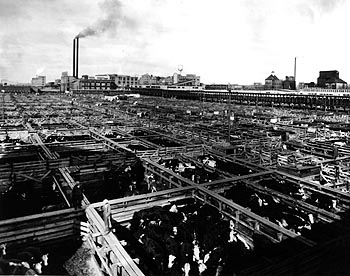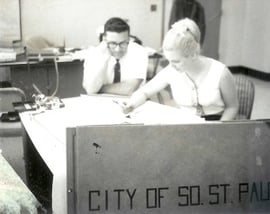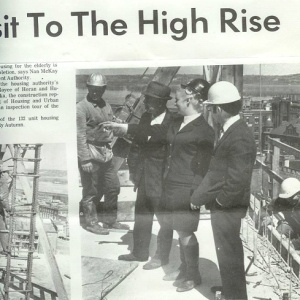Fifty years in housing: Part II
 NMA founder and president Nan McKay is celebrating a major milestone this year: her 50th year in housing. In an ongoing series of posts, she'll be sharing her stories of how the industry has changed over the course of decades.
NMA founder and president Nan McKay is celebrating a major milestone this year: her 50th year in housing. In an ongoing series of posts, she'll be sharing her stories of how the industry has changed over the course of decades.
Nan has previously written for the NMA blog on the topic of executive management and high performance achievement in the HCV program, and was recently profiled in the latest installment of our interview series.
- Part I: Interesting tidbits from 1937 to 1963
- Part II: Urban renewal on Concord Street
- Part III: The most exciting New Year’s Eve
- Part IV: Integrating Concord Street into the new highrise
- Part V: The men of the building
- Part VI: The women of the building
- Part VII: Public housing in the 1960s and 1970s
- Part VIII: The advent of Section 8
A personal history of housing and community development
It's pretty scary to realize that I've been working in subsidized housing since before HUD was created. I started with my first housing authority in 1963, and the Housing and Urban Development Act of 1965 created HUD as a Cabinet-level agency. The Public Housing Administration, U.S. Housing Authority, and House and Home Financing Agency were all swept into the newly formed and reorganized United States Department of Housing and Urban Development (HUD).
In 1963, public housing was both king and queen of subsidized housing. Many public housing projects were built during this period, and if you worked in a housing authority, the manager was a prestigious position. In the larger housing authorities, you had to have a degree to be considered for that job. Since most of the public housing constructed was in larger projects, the manager usually had an office onsite.
In the state where I worked, housing and redevelopment agencies were combined into one agency, which was referred to as an HRA, or Housing and Redevelopment Authority. These agencies were involved in urban renewal. Smaller agencies were allowed to have urban renewal programs as well.
In the first housing authority I worked for, a large agency, I was in the rehabilitation department. We undertook rehabilitation in several neighborhoods of the city and offered grants and loans to owners to rehabilitate their properties. At this time, urban renewal and housing development were the "sexy" departments to be in. Rehabilitation was more of an offshoot from those departments, because you weren't tearing down or building anything. However, many neighborhoods were spruced up, and the stabilization efforts were important.
Urban renewal on Concord Street
My urban renewal experience began in a smaller housing authority, where we worked in a rundown area called "Concord Street." The primary business of the city was the stockyards. Concord Street housed many dilapidated structures, but provided a home for the poorer people (primarily men) to live.
Part of my job was to relocate the people and businesses affected by urban renewal. I was in my early 20s at the time, and I had to ferret out where people lived and procure information from them for relocation purposes. I found Babe, who talked to parking meters; Mary, who was tough enough to be one of the few women who lived in a one-room unit in an old wooden building; and Mike, who was a quiet, interesting guy from "the old country."

In addition to the individual rooms, we found housing for people who worked in the stockyards (which were referred to as "chicken coops.") My boss wouldn't let me go there (he probably figured it was too dangerous for a 24-year-old blonde), but I heard all about them from the guys who went. They were described as little wire cages within a big building, where the men who worked in the stockyard slept.
We discovered that most of the people who had to be relocated, other than the stockyard workers, were elderly. There weren't enough low-cost places to relocate all the elderly people. In addition, we had to figure out what to do with the land once we tore down the buildings and relocated the people. The real reason the city wanted urban renewal was just to get rid of the unsightly Concord Street.
When I interviewed top-of-the-hill residents on what they saw as the potential for bottom-of-the-hill Concord Street, they were appalled that anyone would actually go down there and thought no one ever would, no matter what we did. That did not portend well for the future of our urban renewal project.
I decided to try a different tack. I built a board with wooden blocks representing various types of buildings that could be moved around. I went around to groups and organizations and had them "build" what they wanted to see Concord Street become. It generated a lot of interest in the project.
Sad to say, after all the dilapidated buildings were gone, it never became a big shopping mecca — but there is a new road today with a bank, a couple of restaurants, and a few other businesses. The stockyards eventually folded, and the Stockyards Exchange Building, which was formerly a hive of business activity, became a historical landmark. The chicken coops are gone, but Concord Street remains at the bottom of the hill, looking respectable.
We still had to solve the problem of relocation. We decided to apply for elderly housing. We had to sell the idea, because whenever anyone mentioned public housing, community residents pointed to the "projects" in the nearby larger city, with which they wanted nothing to do.
After many meetings, the housing authority submitted an application to HUD for elderly housing. At the time, elderly housing was restricted to people 62 years of age or older. I wrote and submitted the application. It was
approved and funded, and we opened the project to bids.
We decided to do it as a "turnkey" project. Prior to this method of development, the only choice housing authorities had was to hire an architect who drew the plans. Then the housing authority would bid out the design, buy the land, and bid out the construction. With the new method, turnkey, the developer would present plans and costs and, at the end of the construction project, turn it over to the housing authority when it was ready for occupancy. It was a new way to do the buildings, and I wanted to be in the new wave.
In your 20s, you're excited about everything, especially with a job as much fun as this one was. I'd always been interested in design, although I wasn't an architect or even a reader of plans, but this was my baby and I wanted to do it! I took classes. I learned to read plans. I studied. I questioned people until they were sick of me.
We finally awarded a contract to a developer. I got to go all the way to the HUD office in Chicago to present plans with the developer and report on the construction progress. They didn't have state HUD offices then, only regional offices.
I remember Mr. Papadopolis, a HUD staff person, who reviewed the plans. I think it was hard for him not to wonder why my housing authority had hired this 20-something, and perhaps laugh (behind his hands and my back, of course). I held my head up and talked the talk about the plans like a pro — well, sort of like a pro.
I got a hard hat that barely fit over my updo hairstyle, and I lived every nail in every board and every concrete pour. I stood on each floor as the building went up, and as I looked down into what would be the elevator shaft, I envisioned all the people who were going to live in this wonderful building. The nine-story elderly highrise was being built sort-of-at-the-top-of-the-hill, looking down on Concord Street.
Next: Part III: The most exciting New Year’s Eve
While serving as executive director of a Minnesota housing authority, Nan McKay started one of the nation’s first Section 8 programs. She has devoted the past two years to redesigning NMA’s HCV Executive Management course and rewriting the HCV Executive Management Master Book.



